HRM Practices and Strategies: A Case Study on Tesco PLC
VerifiedAdded on 2022/08/24
|22
|5714
|21
Report
AI Summary
This report delves into the human resource management (HRM) practices of Tesco PLC, examining the differences between domestic and international strategies within the multinational corporation. It explores key factors such as risk exposure, external influences, and employee engagement, highlighting the significance of pre-departure training, verification processes, and ethical conduct. The report analyzes Tesco's strategic focus, including its commitment to customer and employee well-being, and its approach to recruitment, organizational development, rewards, and training. It also addresses the importance of safe working environments, policy revisions, and the integration of inclusive practices. The analysis covers the HRM cycle and the strategies employed for managing the workforce, emphasizing the role of managers in decision-making, the use of social media for communication, and the effective utilization of employee core competencies. The report also includes a summary of team member contributions and a brief overview of the presentation given to foreign delegates.
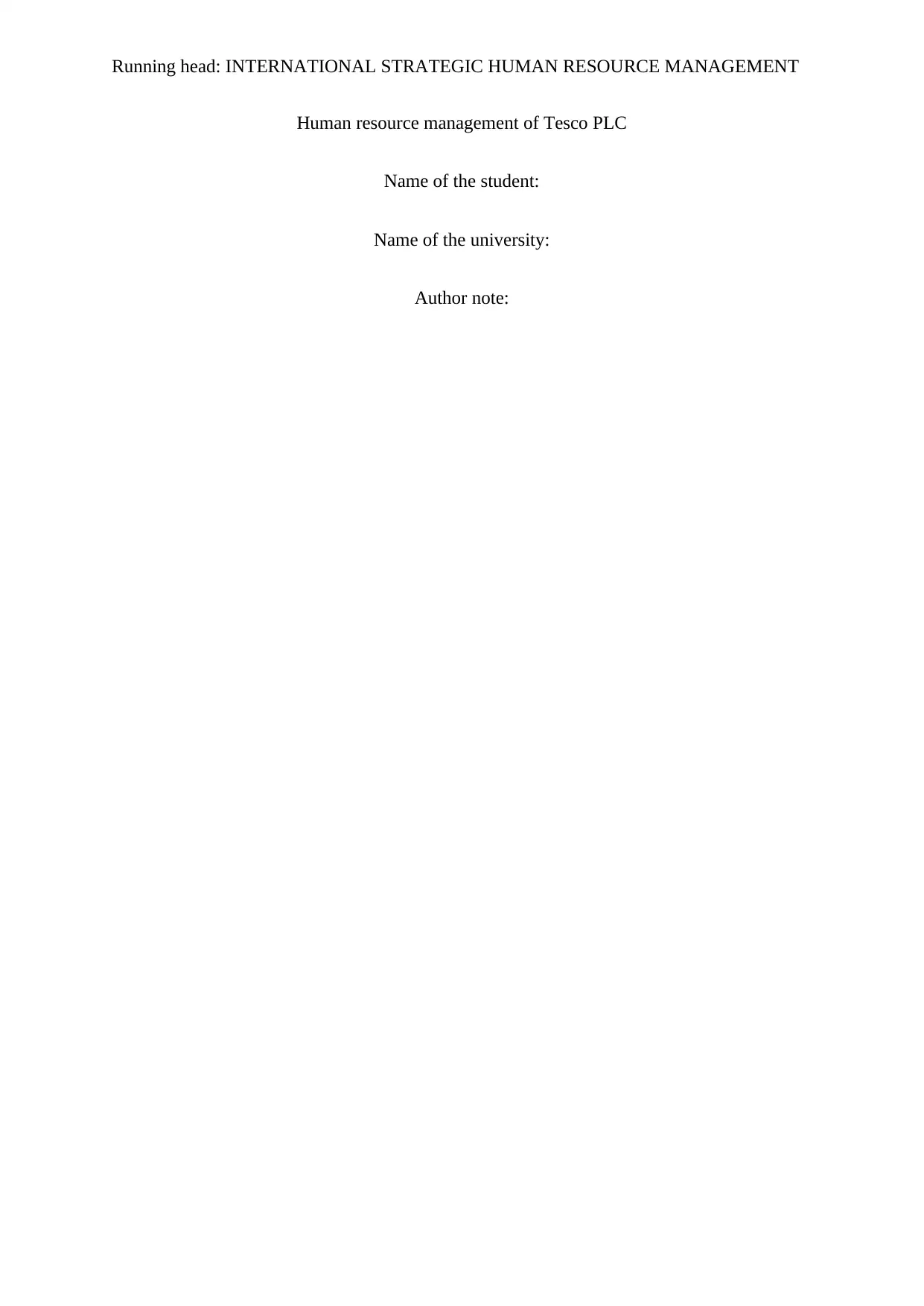
Running head: INTERNATIONAL STRATEGIC HUMAN RESOURCE MANAGEMENT
Human resource management of Tesco PLC
Name of the student:
Name of the university:
Author note:
Human resource management of Tesco PLC
Name of the student:
Name of the university:
Author note:
Paraphrase This Document
Need a fresh take? Get an instant paraphrase of this document with our AI Paraphraser
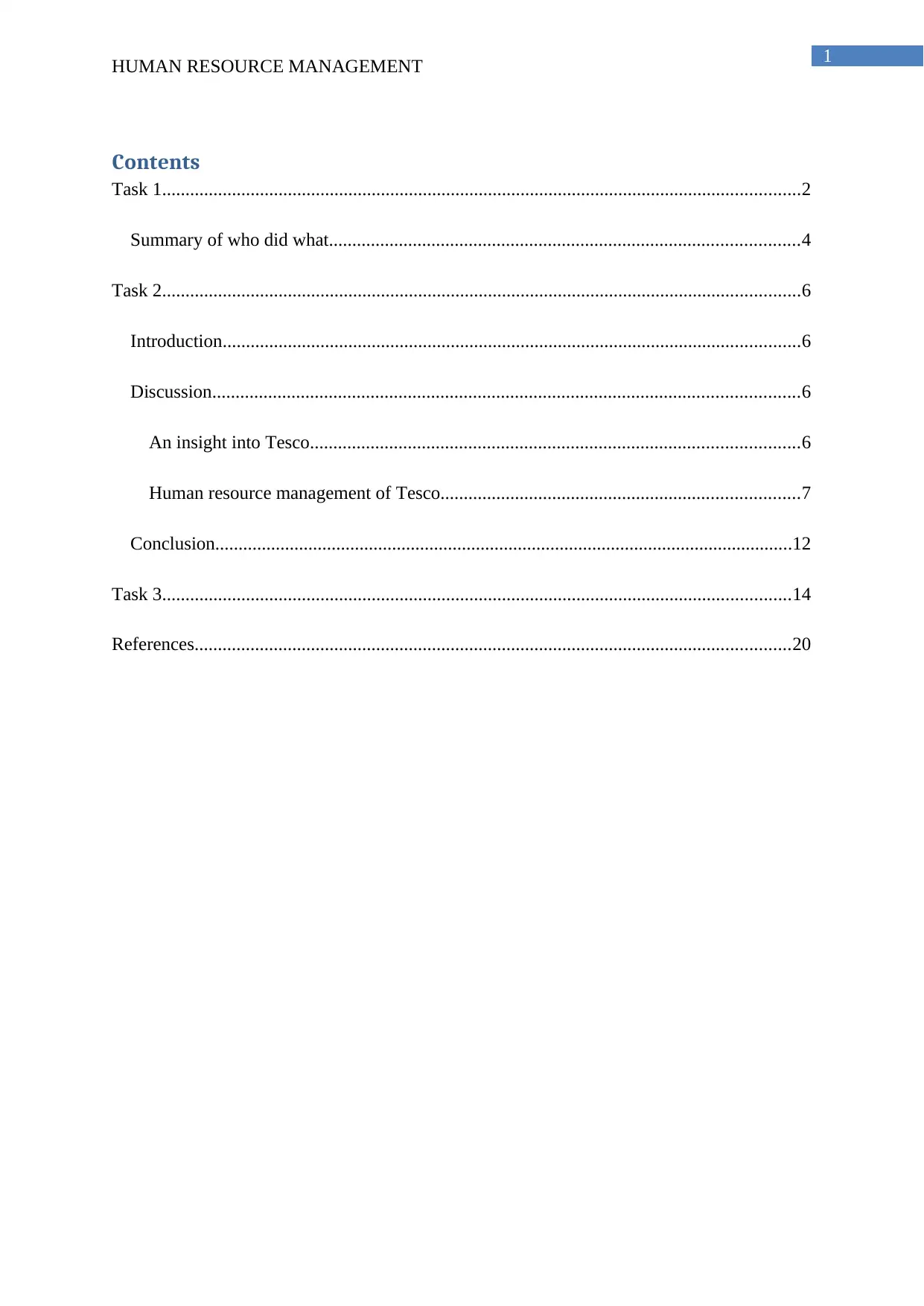
1
HUMAN RESOURCE MANAGEMENT
Contents
Task 1.........................................................................................................................................2
Summary of who did what.....................................................................................................4
Task 2.........................................................................................................................................6
Introduction............................................................................................................................6
Discussion..............................................................................................................................6
An insight into Tesco.........................................................................................................6
Human resource management of Tesco.............................................................................7
Conclusion............................................................................................................................12
Task 3.......................................................................................................................................14
References................................................................................................................................20
HUMAN RESOURCE MANAGEMENT
Contents
Task 1.........................................................................................................................................2
Summary of who did what.....................................................................................................4
Task 2.........................................................................................................................................6
Introduction............................................................................................................................6
Discussion..............................................................................................................................6
An insight into Tesco.........................................................................................................6
Human resource management of Tesco.............................................................................7
Conclusion............................................................................................................................12
Task 3.......................................................................................................................................14
References................................................................................................................................20
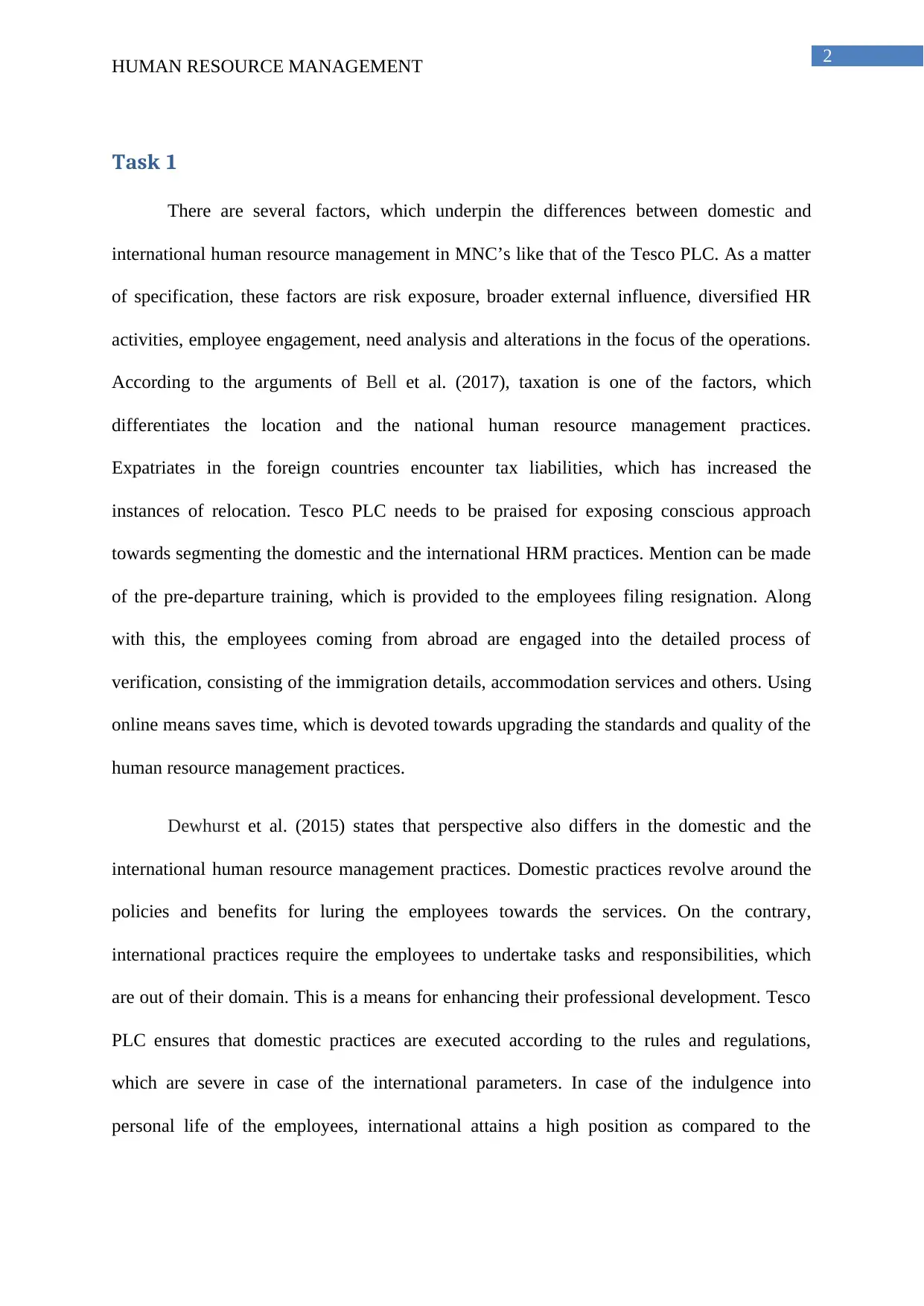
2
HUMAN RESOURCE MANAGEMENT
Task 1
There are several factors, which underpin the differences between domestic and
international human resource management in MNC’s like that of the Tesco PLC. As a matter
of specification, these factors are risk exposure, broader external influence, diversified HR
activities, employee engagement, need analysis and alterations in the focus of the operations.
According to the arguments of Bell et al. (2017), taxation is one of the factors, which
differentiates the location and the national human resource management practices.
Expatriates in the foreign countries encounter tax liabilities, which has increased the
instances of relocation. Tesco PLC needs to be praised for exposing conscious approach
towards segmenting the domestic and the international HRM practices. Mention can be made
of the pre-departure training, which is provided to the employees filing resignation. Along
with this, the employees coming from abroad are engaged into the detailed process of
verification, consisting of the immigration details, accommodation services and others. Using
online means saves time, which is devoted towards upgrading the standards and quality of the
human resource management practices.
Dewhurst et al. (2015) states that perspective also differs in the domestic and the
international human resource management practices. Domestic practices revolve around the
policies and benefits for luring the employees towards the services. On the contrary,
international practices require the employees to undertake tasks and responsibilities, which
are out of their domain. This is a means for enhancing their professional development. Tesco
PLC ensures that domestic practices are executed according to the rules and regulations,
which are severe in case of the international parameters. In case of the indulgence into
personal life of the employees, international attains a high position as compared to the
HUMAN RESOURCE MANAGEMENT
Task 1
There are several factors, which underpin the differences between domestic and
international human resource management in MNC’s like that of the Tesco PLC. As a matter
of specification, these factors are risk exposure, broader external influence, diversified HR
activities, employee engagement, need analysis and alterations in the focus of the operations.
According to the arguments of Bell et al. (2017), taxation is one of the factors, which
differentiates the location and the national human resource management practices.
Expatriates in the foreign countries encounter tax liabilities, which has increased the
instances of relocation. Tesco PLC needs to be praised for exposing conscious approach
towards segmenting the domestic and the international HRM practices. Mention can be made
of the pre-departure training, which is provided to the employees filing resignation. Along
with this, the employees coming from abroad are engaged into the detailed process of
verification, consisting of the immigration details, accommodation services and others. Using
online means saves time, which is devoted towards upgrading the standards and quality of the
human resource management practices.
Dewhurst et al. (2015) states that perspective also differs in the domestic and the
international human resource management practices. Domestic practices revolve around the
policies and benefits for luring the employees towards the services. On the contrary,
international practices require the employees to undertake tasks and responsibilities, which
are out of their domain. This is a means for enhancing their professional development. Tesco
PLC ensures that domestic practices are executed according to the rules and regulations,
which are severe in case of the international parameters. In case of the indulgence into
personal life of the employees, international attains a high position as compared to the
⊘ This is a preview!⊘
Do you want full access?
Subscribe today to unlock all pages.

Trusted by 1+ million students worldwide
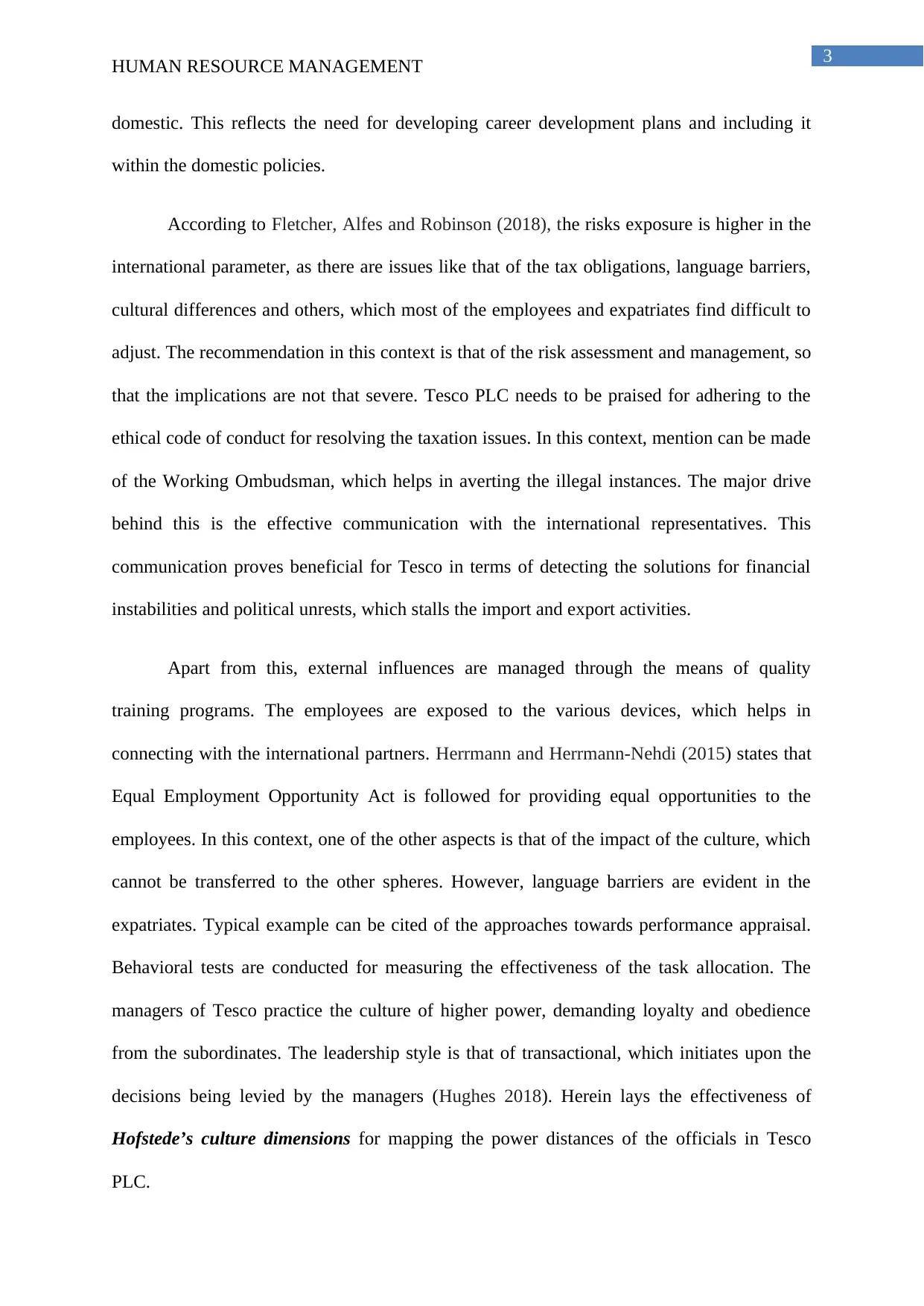
3
HUMAN RESOURCE MANAGEMENT
domestic. This reflects the need for developing career development plans and including it
within the domestic policies.
According to Fletcher, Alfes and Robinson (2018), the risks exposure is higher in the
international parameter, as there are issues like that of the tax obligations, language barriers,
cultural differences and others, which most of the employees and expatriates find difficult to
adjust. The recommendation in this context is that of the risk assessment and management, so
that the implications are not that severe. Tesco PLC needs to be praised for adhering to the
ethical code of conduct for resolving the taxation issues. In this context, mention can be made
of the Working Ombudsman, which helps in averting the illegal instances. The major drive
behind this is the effective communication with the international representatives. This
communication proves beneficial for Tesco in terms of detecting the solutions for financial
instabilities and political unrests, which stalls the import and export activities.
Apart from this, external influences are managed through the means of quality
training programs. The employees are exposed to the various devices, which helps in
connecting with the international partners. Herrmann and Herrmann-Nehdi (2015) states that
Equal Employment Opportunity Act is followed for providing equal opportunities to the
employees. In this context, one of the other aspects is that of the impact of the culture, which
cannot be transferred to the other spheres. However, language barriers are evident in the
expatriates. Typical example can be cited of the approaches towards performance appraisal.
Behavioral tests are conducted for measuring the effectiveness of the task allocation. The
managers of Tesco practice the culture of higher power, demanding loyalty and obedience
from the subordinates. The leadership style is that of transactional, which initiates upon the
decisions being levied by the managers (Hughes 2018). Herein lays the effectiveness of
Hofstede’s culture dimensions for mapping the power distances of the officials in Tesco
PLC.
HUMAN RESOURCE MANAGEMENT
domestic. This reflects the need for developing career development plans and including it
within the domestic policies.
According to Fletcher, Alfes and Robinson (2018), the risks exposure is higher in the
international parameter, as there are issues like that of the tax obligations, language barriers,
cultural differences and others, which most of the employees and expatriates find difficult to
adjust. The recommendation in this context is that of the risk assessment and management, so
that the implications are not that severe. Tesco PLC needs to be praised for adhering to the
ethical code of conduct for resolving the taxation issues. In this context, mention can be made
of the Working Ombudsman, which helps in averting the illegal instances. The major drive
behind this is the effective communication with the international representatives. This
communication proves beneficial for Tesco in terms of detecting the solutions for financial
instabilities and political unrests, which stalls the import and export activities.
Apart from this, external influences are managed through the means of quality
training programs. The employees are exposed to the various devices, which helps in
connecting with the international partners. Herrmann and Herrmann-Nehdi (2015) states that
Equal Employment Opportunity Act is followed for providing equal opportunities to the
employees. In this context, one of the other aspects is that of the impact of the culture, which
cannot be transferred to the other spheres. However, language barriers are evident in the
expatriates. Typical example can be cited of the approaches towards performance appraisal.
Behavioral tests are conducted for measuring the effectiveness of the task allocation. The
managers of Tesco practice the culture of higher power, demanding loyalty and obedience
from the subordinates. The leadership style is that of transactional, which initiates upon the
decisions being levied by the managers (Hughes 2018). Herein lays the effectiveness of
Hofstede’s culture dimensions for mapping the power distances of the officials in Tesco
PLC.
Paraphrase This Document
Need a fresh take? Get an instant paraphrase of this document with our AI Paraphraser
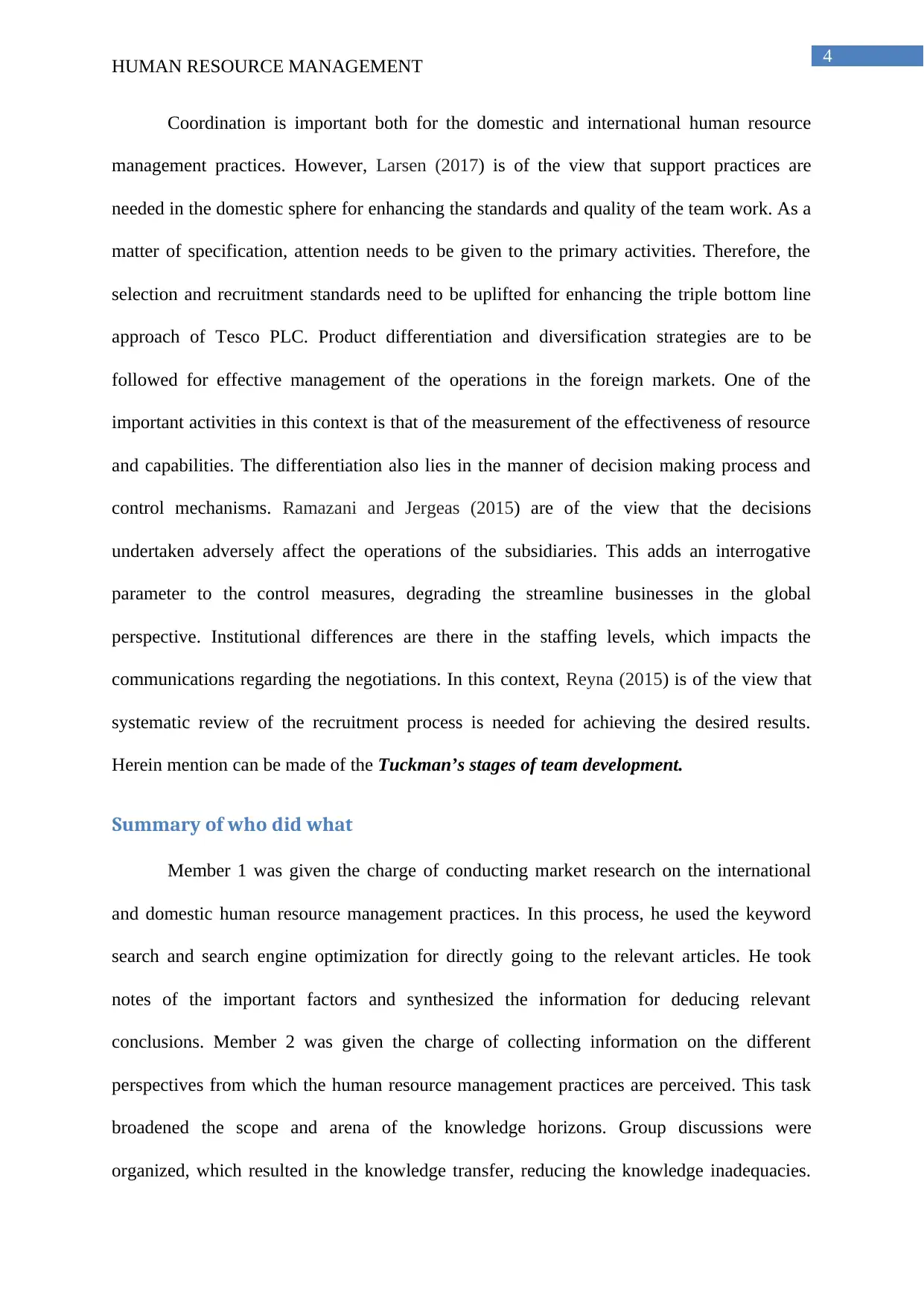
4
HUMAN RESOURCE MANAGEMENT
Coordination is important both for the domestic and international human resource
management practices. However, Larsen (2017) is of the view that support practices are
needed in the domestic sphere for enhancing the standards and quality of the team work. As a
matter of specification, attention needs to be given to the primary activities. Therefore, the
selection and recruitment standards need to be uplifted for enhancing the triple bottom line
approach of Tesco PLC. Product differentiation and diversification strategies are to be
followed for effective management of the operations in the foreign markets. One of the
important activities in this context is that of the measurement of the effectiveness of resource
and capabilities. The differentiation also lies in the manner of decision making process and
control mechanisms. Ramazani and Jergeas (2015) are of the view that the decisions
undertaken adversely affect the operations of the subsidiaries. This adds an interrogative
parameter to the control measures, degrading the streamline businesses in the global
perspective. Institutional differences are there in the staffing levels, which impacts the
communications regarding the negotiations. In this context, Reyna (2015) is of the view that
systematic review of the recruitment process is needed for achieving the desired results.
Herein mention can be made of the Tuckman’s stages of team development.
Summary of who did what
Member 1 was given the charge of conducting market research on the international
and domestic human resource management practices. In this process, he used the keyword
search and search engine optimization for directly going to the relevant articles. He took
notes of the important factors and synthesized the information for deducing relevant
conclusions. Member 2 was given the charge of collecting information on the different
perspectives from which the human resource management practices are perceived. This task
broadened the scope and arena of the knowledge horizons. Group discussions were
organized, which resulted in the knowledge transfer, reducing the knowledge inadequacies.
HUMAN RESOURCE MANAGEMENT
Coordination is important both for the domestic and international human resource
management practices. However, Larsen (2017) is of the view that support practices are
needed in the domestic sphere for enhancing the standards and quality of the team work. As a
matter of specification, attention needs to be given to the primary activities. Therefore, the
selection and recruitment standards need to be uplifted for enhancing the triple bottom line
approach of Tesco PLC. Product differentiation and diversification strategies are to be
followed for effective management of the operations in the foreign markets. One of the
important activities in this context is that of the measurement of the effectiveness of resource
and capabilities. The differentiation also lies in the manner of decision making process and
control mechanisms. Ramazani and Jergeas (2015) are of the view that the decisions
undertaken adversely affect the operations of the subsidiaries. This adds an interrogative
parameter to the control measures, degrading the streamline businesses in the global
perspective. Institutional differences are there in the staffing levels, which impacts the
communications regarding the negotiations. In this context, Reyna (2015) is of the view that
systematic review of the recruitment process is needed for achieving the desired results.
Herein mention can be made of the Tuckman’s stages of team development.
Summary of who did what
Member 1 was given the charge of conducting market research on the international
and domestic human resource management practices. In this process, he used the keyword
search and search engine optimization for directly going to the relevant articles. He took
notes of the important factors and synthesized the information for deducing relevant
conclusions. Member 2 was given the charge of collecting information on the different
perspectives from which the human resource management practices are perceived. This task
broadened the scope and arena of the knowledge horizons. Group discussions were
organized, which resulted in the knowledge transfer, reducing the knowledge inadequacies.
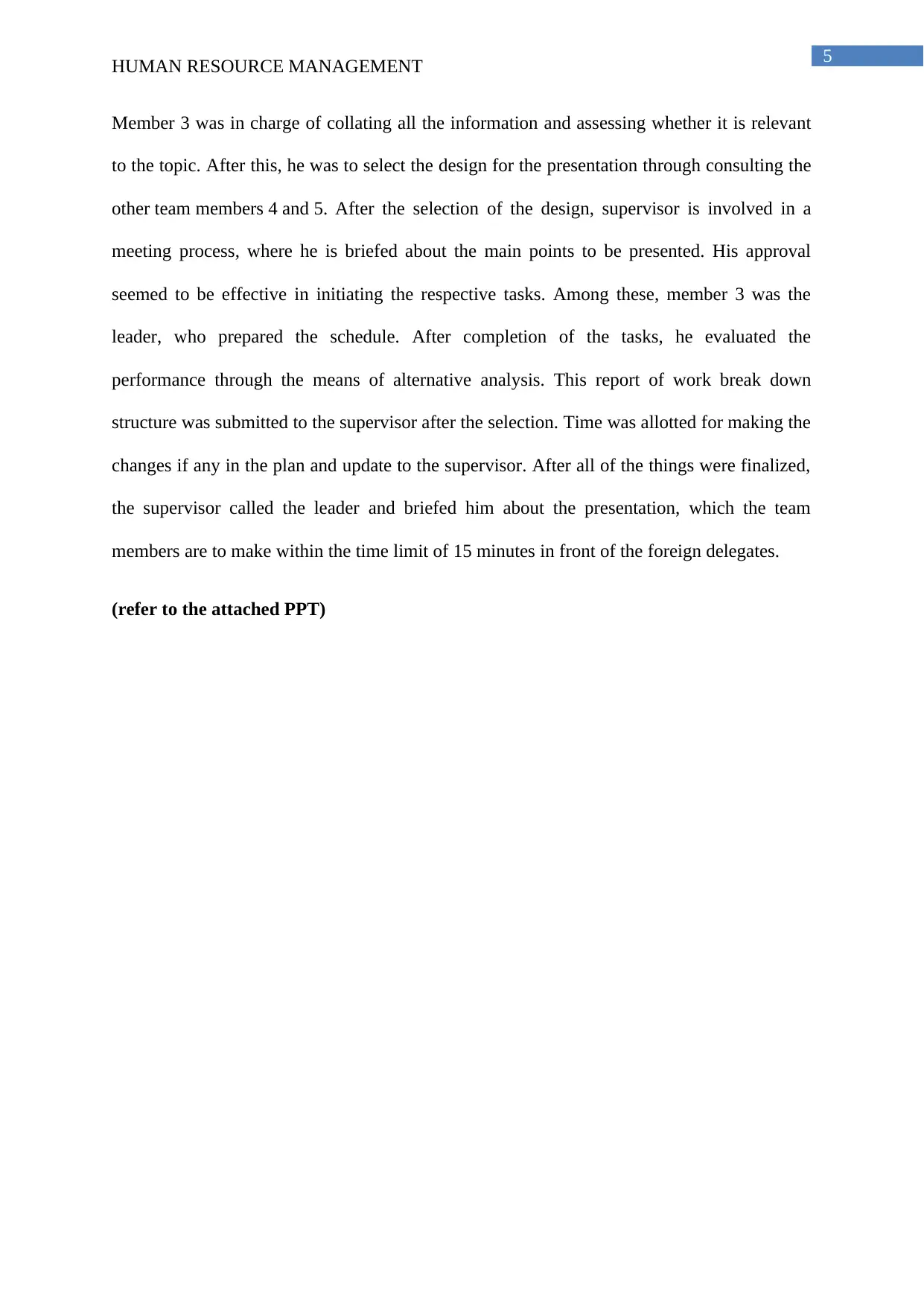
5
HUMAN RESOURCE MANAGEMENT
Member 3 was in charge of collating all the information and assessing whether it is relevant
to the topic. After this, he was to select the design for the presentation through consulting the
other team members 4 and 5. After the selection of the design, supervisor is involved in a
meeting process, where he is briefed about the main points to be presented. His approval
seemed to be effective in initiating the respective tasks. Among these, member 3 was the
leader, who prepared the schedule. After completion of the tasks, he evaluated the
performance through the means of alternative analysis. This report of work break down
structure was submitted to the supervisor after the selection. Time was allotted for making the
changes if any in the plan and update to the supervisor. After all of the things were finalized,
the supervisor called the leader and briefed him about the presentation, which the team
members are to make within the time limit of 15 minutes in front of the foreign delegates.
(refer to the attached PPT)
HUMAN RESOURCE MANAGEMENT
Member 3 was in charge of collating all the information and assessing whether it is relevant
to the topic. After this, he was to select the design for the presentation through consulting the
other team members 4 and 5. After the selection of the design, supervisor is involved in a
meeting process, where he is briefed about the main points to be presented. His approval
seemed to be effective in initiating the respective tasks. Among these, member 3 was the
leader, who prepared the schedule. After completion of the tasks, he evaluated the
performance through the means of alternative analysis. This report of work break down
structure was submitted to the supervisor after the selection. Time was allotted for making the
changes if any in the plan and update to the supervisor. After all of the things were finalized,
the supervisor called the leader and briefed him about the presentation, which the team
members are to make within the time limit of 15 minutes in front of the foreign delegates.
(refer to the attached PPT)
⊘ This is a preview!⊘
Do you want full access?
Subscribe today to unlock all pages.

Trusted by 1+ million students worldwide
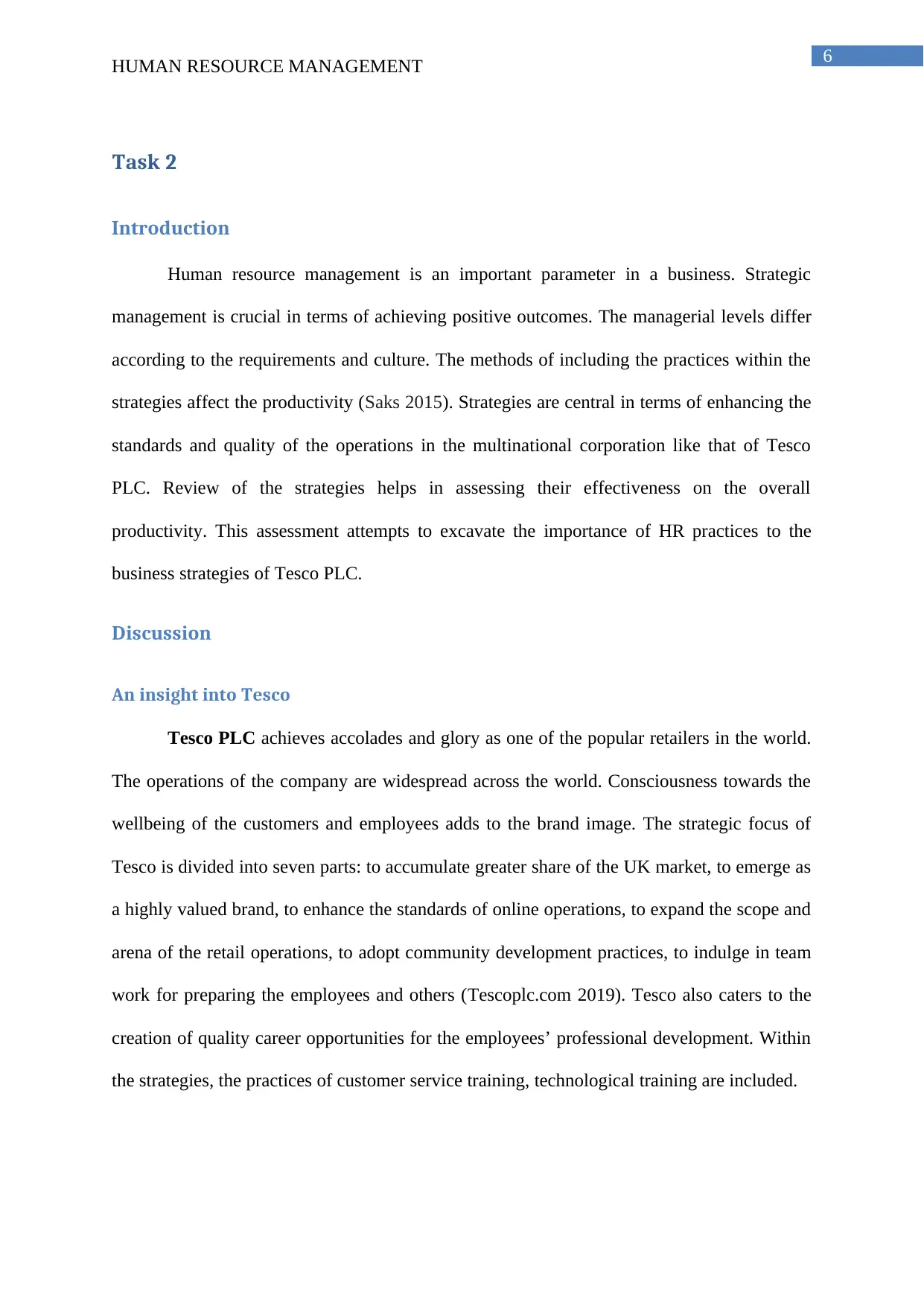
6
HUMAN RESOURCE MANAGEMENT
Task 2
Introduction
Human resource management is an important parameter in a business. Strategic
management is crucial in terms of achieving positive outcomes. The managerial levels differ
according to the requirements and culture. The methods of including the practices within the
strategies affect the productivity (Saks 2015). Strategies are central in terms of enhancing the
standards and quality of the operations in the multinational corporation like that of Tesco
PLC. Review of the strategies helps in assessing their effectiveness on the overall
productivity. This assessment attempts to excavate the importance of HR practices to the
business strategies of Tesco PLC.
Discussion
An insight into Tesco
Tesco PLC achieves accolades and glory as one of the popular retailers in the world.
The operations of the company are widespread across the world. Consciousness towards the
wellbeing of the customers and employees adds to the brand image. The strategic focus of
Tesco is divided into seven parts: to accumulate greater share of the UK market, to emerge as
a highly valued brand, to enhance the standards of online operations, to expand the scope and
arena of the retail operations, to adopt community development practices, to indulge in team
work for preparing the employees and others (Tescoplc.com 2019). Tesco also caters to the
creation of quality career opportunities for the employees’ professional development. Within
the strategies, the practices of customer service training, technological training are included.
HUMAN RESOURCE MANAGEMENT
Task 2
Introduction
Human resource management is an important parameter in a business. Strategic
management is crucial in terms of achieving positive outcomes. The managerial levels differ
according to the requirements and culture. The methods of including the practices within the
strategies affect the productivity (Saks 2015). Strategies are central in terms of enhancing the
standards and quality of the operations in the multinational corporation like that of Tesco
PLC. Review of the strategies helps in assessing their effectiveness on the overall
productivity. This assessment attempts to excavate the importance of HR practices to the
business strategies of Tesco PLC.
Discussion
An insight into Tesco
Tesco PLC achieves accolades and glory as one of the popular retailers in the world.
The operations of the company are widespread across the world. Consciousness towards the
wellbeing of the customers and employees adds to the brand image. The strategic focus of
Tesco is divided into seven parts: to accumulate greater share of the UK market, to emerge as
a highly valued brand, to enhance the standards of online operations, to expand the scope and
arena of the retail operations, to adopt community development practices, to indulge in team
work for preparing the employees and others (Tescoplc.com 2019). Tesco also caters to the
creation of quality career opportunities for the employees’ professional development. Within
the strategies, the practices of customer service training, technological training are included.
Paraphrase This Document
Need a fresh take? Get an instant paraphrase of this document with our AI Paraphraser
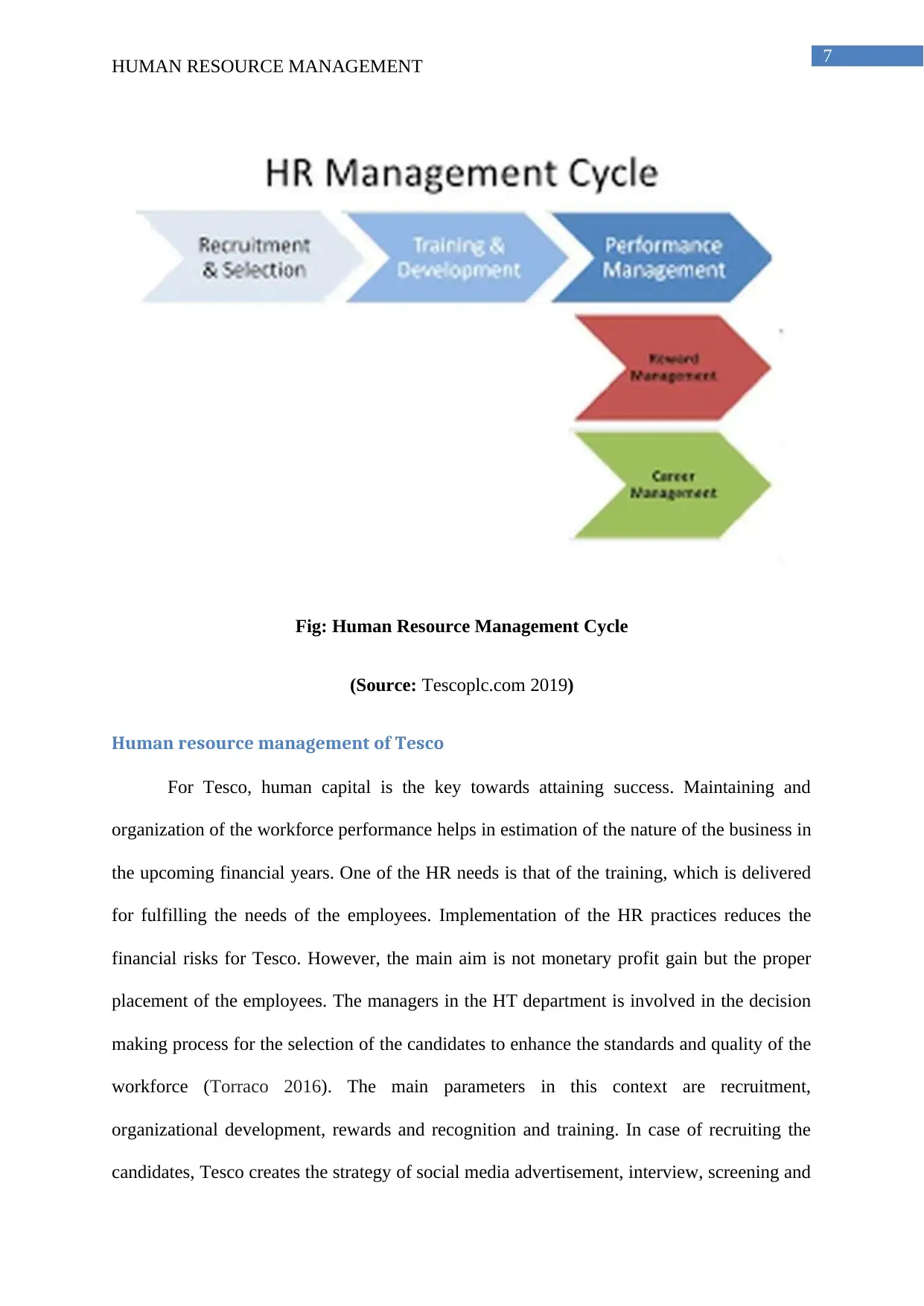
7
HUMAN RESOURCE MANAGEMENT
Fig: Human Resource Management Cycle
(Source: Tescoplc.com 2019)
Human resource management of Tesco
For Tesco, human capital is the key towards attaining success. Maintaining and
organization of the workforce performance helps in estimation of the nature of the business in
the upcoming financial years. One of the HR needs is that of the training, which is delivered
for fulfilling the needs of the employees. Implementation of the HR practices reduces the
financial risks for Tesco. However, the main aim is not monetary profit gain but the proper
placement of the employees. The managers in the HT department is involved in the decision
making process for the selection of the candidates to enhance the standards and quality of the
workforce (Torraco 2016). The main parameters in this context are recruitment,
organizational development, rewards and recognition and training. In case of recruiting the
candidates, Tesco creates the strategy of social media advertisement, interview, screening and
HUMAN RESOURCE MANAGEMENT
Fig: Human Resource Management Cycle
(Source: Tescoplc.com 2019)
Human resource management of Tesco
For Tesco, human capital is the key towards attaining success. Maintaining and
organization of the workforce performance helps in estimation of the nature of the business in
the upcoming financial years. One of the HR needs is that of the training, which is delivered
for fulfilling the needs of the employees. Implementation of the HR practices reduces the
financial risks for Tesco. However, the main aim is not monetary profit gain but the proper
placement of the employees. The managers in the HT department is involved in the decision
making process for the selection of the candidates to enhance the standards and quality of the
workforce (Torraco 2016). The main parameters in this context are recruitment,
organizational development, rewards and recognition and training. In case of recruiting the
candidates, Tesco creates the strategy of social media advertisement, interview, screening and
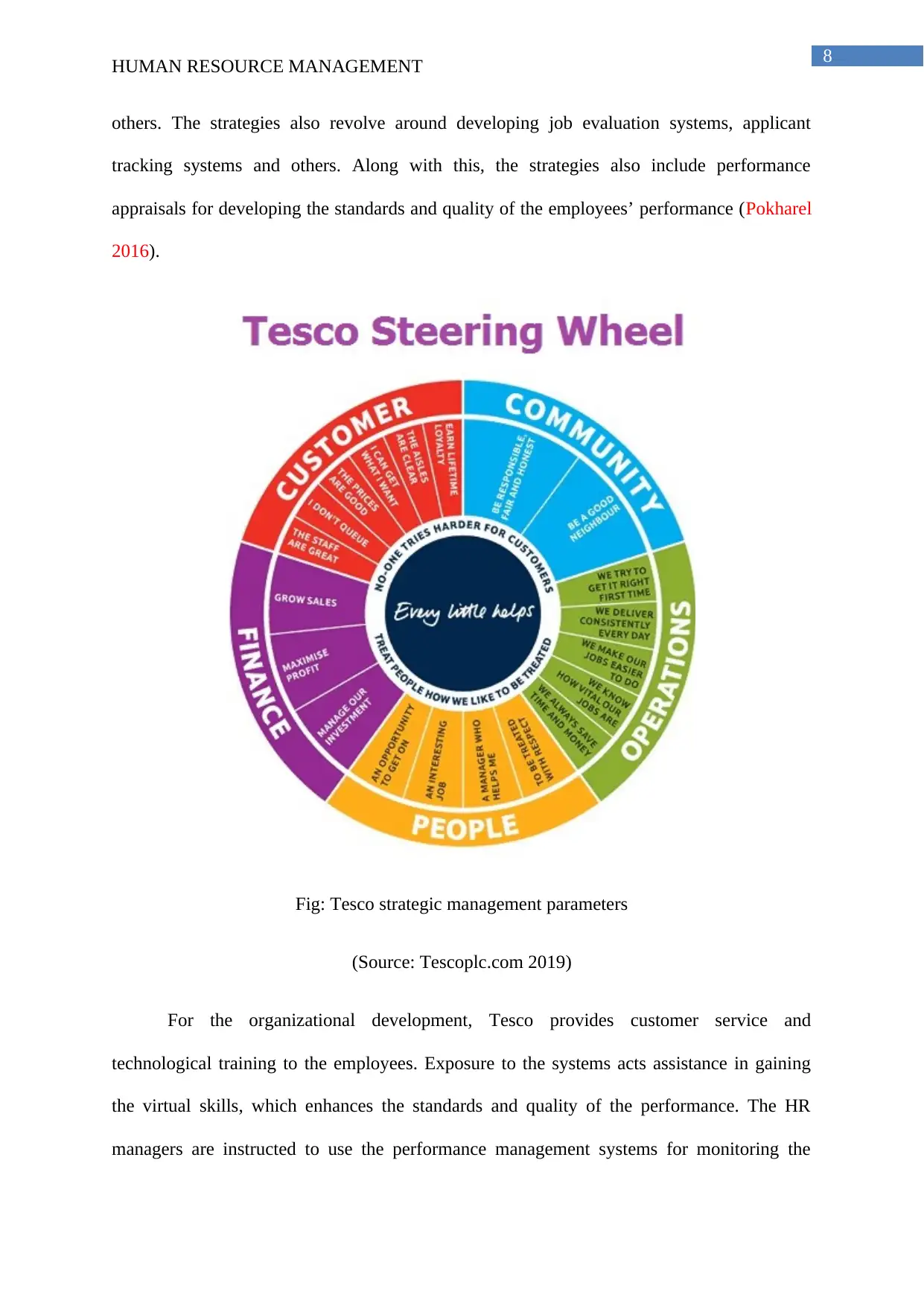
8
HUMAN RESOURCE MANAGEMENT
others. The strategies also revolve around developing job evaluation systems, applicant
tracking systems and others. Along with this, the strategies also include performance
appraisals for developing the standards and quality of the employees’ performance (Pokharel
2016).
Fig: Tesco strategic management parameters
(Source: Tescoplc.com 2019)
For the organizational development, Tesco provides customer service and
technological training to the employees. Exposure to the systems acts assistance in gaining
the virtual skills, which enhances the standards and quality of the performance. The HR
managers are instructed to use the performance management systems for monitoring the
HUMAN RESOURCE MANAGEMENT
others. The strategies also revolve around developing job evaluation systems, applicant
tracking systems and others. Along with this, the strategies also include performance
appraisals for developing the standards and quality of the employees’ performance (Pokharel
2016).
Fig: Tesco strategic management parameters
(Source: Tescoplc.com 2019)
For the organizational development, Tesco provides customer service and
technological training to the employees. Exposure to the systems acts assistance in gaining
the virtual skills, which enhances the standards and quality of the performance. The HR
managers are instructed to use the performance management systems for monitoring the
⊘ This is a preview!⊘
Do you want full access?
Subscribe today to unlock all pages.

Trusted by 1+ million students worldwide
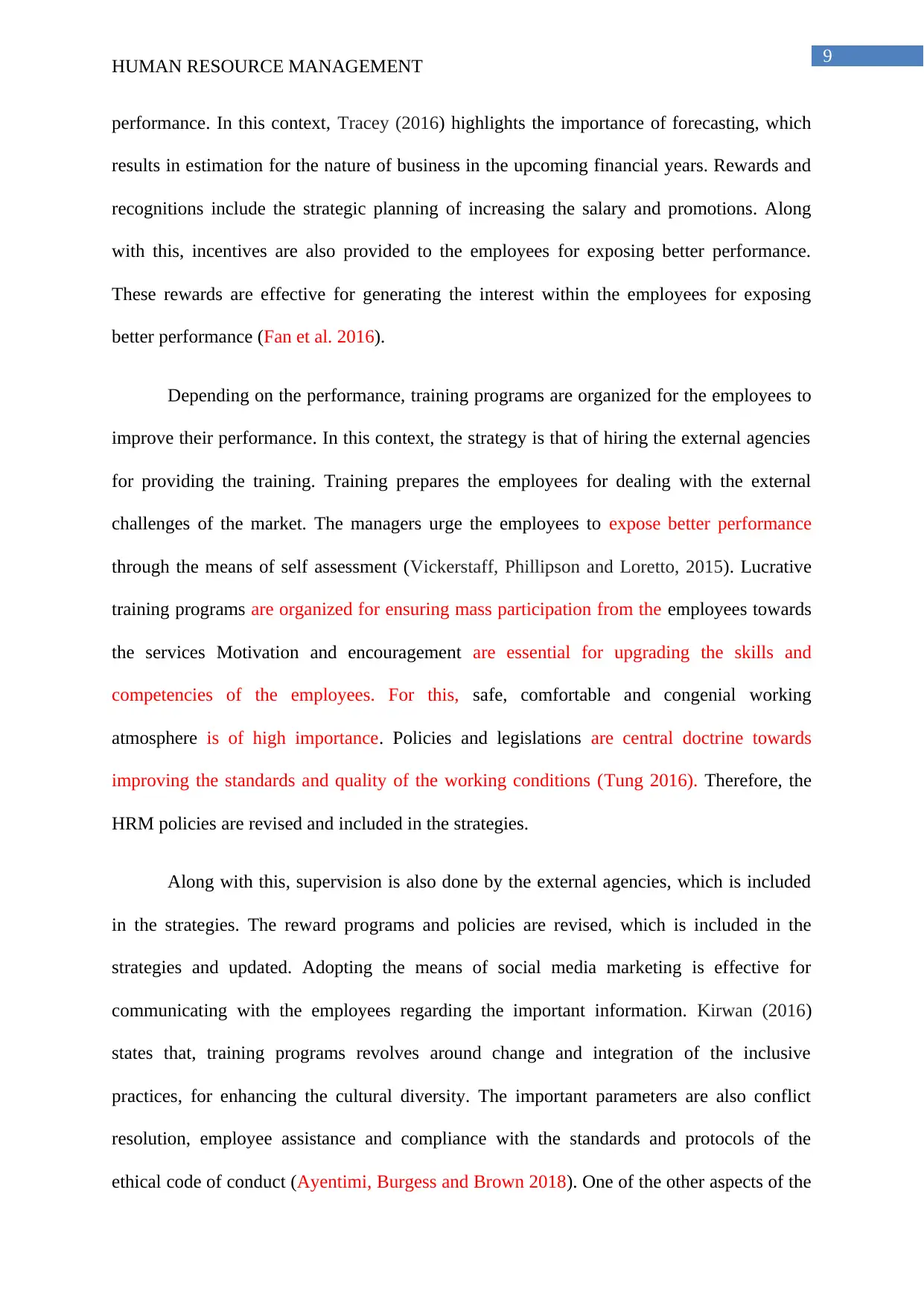
9
HUMAN RESOURCE MANAGEMENT
performance. In this context, Tracey (2016) highlights the importance of forecasting, which
results in estimation for the nature of business in the upcoming financial years. Rewards and
recognitions include the strategic planning of increasing the salary and promotions. Along
with this, incentives are also provided to the employees for exposing better performance.
These rewards are effective for generating the interest within the employees for exposing
better performance (Fan et al. 2016).
Depending on the performance, training programs are organized for the employees to
improve their performance. In this context, the strategy is that of hiring the external agencies
for providing the training. Training prepares the employees for dealing with the external
challenges of the market. The managers urge the employees to expose better performance
through the means of self assessment (Vickerstaff, Phillipson and Loretto, 2015). Lucrative
training programs are organized for ensuring mass participation from the employees towards
the services Motivation and encouragement are essential for upgrading the skills and
competencies of the employees. For this, safe, comfortable and congenial working
atmosphere is of high importance. Policies and legislations are central doctrine towards
improving the standards and quality of the working conditions (Tung 2016). Therefore, the
HRM policies are revised and included in the strategies.
Along with this, supervision is also done by the external agencies, which is included
in the strategies. The reward programs and policies are revised, which is included in the
strategies and updated. Adopting the means of social media marketing is effective for
communicating with the employees regarding the important information. Kirwan (2016)
states that, training programs revolves around change and integration of the inclusive
practices, for enhancing the cultural diversity. The important parameters are also conflict
resolution, employee assistance and compliance with the standards and protocols of the
ethical code of conduct (Ayentimi, Burgess and Brown 2018). One of the other aspects of the
HUMAN RESOURCE MANAGEMENT
performance. In this context, Tracey (2016) highlights the importance of forecasting, which
results in estimation for the nature of business in the upcoming financial years. Rewards and
recognitions include the strategic planning of increasing the salary and promotions. Along
with this, incentives are also provided to the employees for exposing better performance.
These rewards are effective for generating the interest within the employees for exposing
better performance (Fan et al. 2016).
Depending on the performance, training programs are organized for the employees to
improve their performance. In this context, the strategy is that of hiring the external agencies
for providing the training. Training prepares the employees for dealing with the external
challenges of the market. The managers urge the employees to expose better performance
through the means of self assessment (Vickerstaff, Phillipson and Loretto, 2015). Lucrative
training programs are organized for ensuring mass participation from the employees towards
the services Motivation and encouragement are essential for upgrading the skills and
competencies of the employees. For this, safe, comfortable and congenial working
atmosphere is of high importance. Policies and legislations are central doctrine towards
improving the standards and quality of the working conditions (Tung 2016). Therefore, the
HRM policies are revised and included in the strategies.
Along with this, supervision is also done by the external agencies, which is included
in the strategies. The reward programs and policies are revised, which is included in the
strategies and updated. Adopting the means of social media marketing is effective for
communicating with the employees regarding the important information. Kirwan (2016)
states that, training programs revolves around change and integration of the inclusive
practices, for enhancing the cultural diversity. The important parameters are also conflict
resolution, employee assistance and compliance with the standards and protocols of the
ethical code of conduct (Ayentimi, Burgess and Brown 2018). One of the other aspects of the
Paraphrase This Document
Need a fresh take? Get an instant paraphrase of this document with our AI Paraphraser
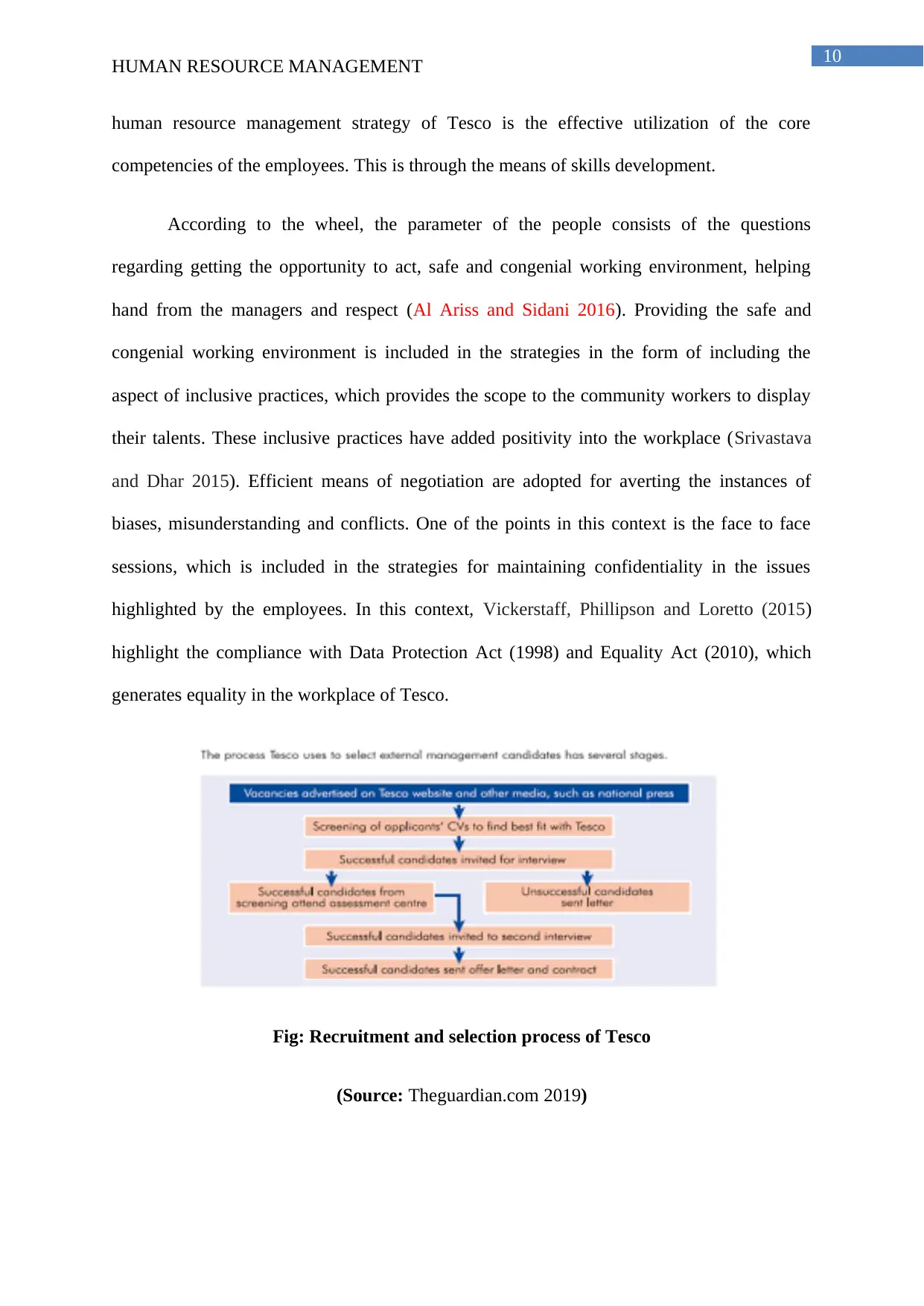
10
HUMAN RESOURCE MANAGEMENT
human resource management strategy of Tesco is the effective utilization of the core
competencies of the employees. This is through the means of skills development.
According to the wheel, the parameter of the people consists of the questions
regarding getting the opportunity to act, safe and congenial working environment, helping
hand from the managers and respect (Al Ariss and Sidani 2016). Providing the safe and
congenial working environment is included in the strategies in the form of including the
aspect of inclusive practices, which provides the scope to the community workers to display
their talents. These inclusive practices have added positivity into the workplace (Srivastava
and Dhar 2015). Efficient means of negotiation are adopted for averting the instances of
biases, misunderstanding and conflicts. One of the points in this context is the face to face
sessions, which is included in the strategies for maintaining confidentiality in the issues
highlighted by the employees. In this context, Vickerstaff, Phillipson and Loretto (2015)
highlight the compliance with Data Protection Act (1998) and Equality Act (2010), which
generates equality in the workplace of Tesco.
Fig: Recruitment and selection process of Tesco
(Source: Theguardian.com 2019)
HUMAN RESOURCE MANAGEMENT
human resource management strategy of Tesco is the effective utilization of the core
competencies of the employees. This is through the means of skills development.
According to the wheel, the parameter of the people consists of the questions
regarding getting the opportunity to act, safe and congenial working environment, helping
hand from the managers and respect (Al Ariss and Sidani 2016). Providing the safe and
congenial working environment is included in the strategies in the form of including the
aspect of inclusive practices, which provides the scope to the community workers to display
their talents. These inclusive practices have added positivity into the workplace (Srivastava
and Dhar 2015). Efficient means of negotiation are adopted for averting the instances of
biases, misunderstanding and conflicts. One of the points in this context is the face to face
sessions, which is included in the strategies for maintaining confidentiality in the issues
highlighted by the employees. In this context, Vickerstaff, Phillipson and Loretto (2015)
highlight the compliance with Data Protection Act (1998) and Equality Act (2010), which
generates equality in the workplace of Tesco.
Fig: Recruitment and selection process of Tesco
(Source: Theguardian.com 2019)
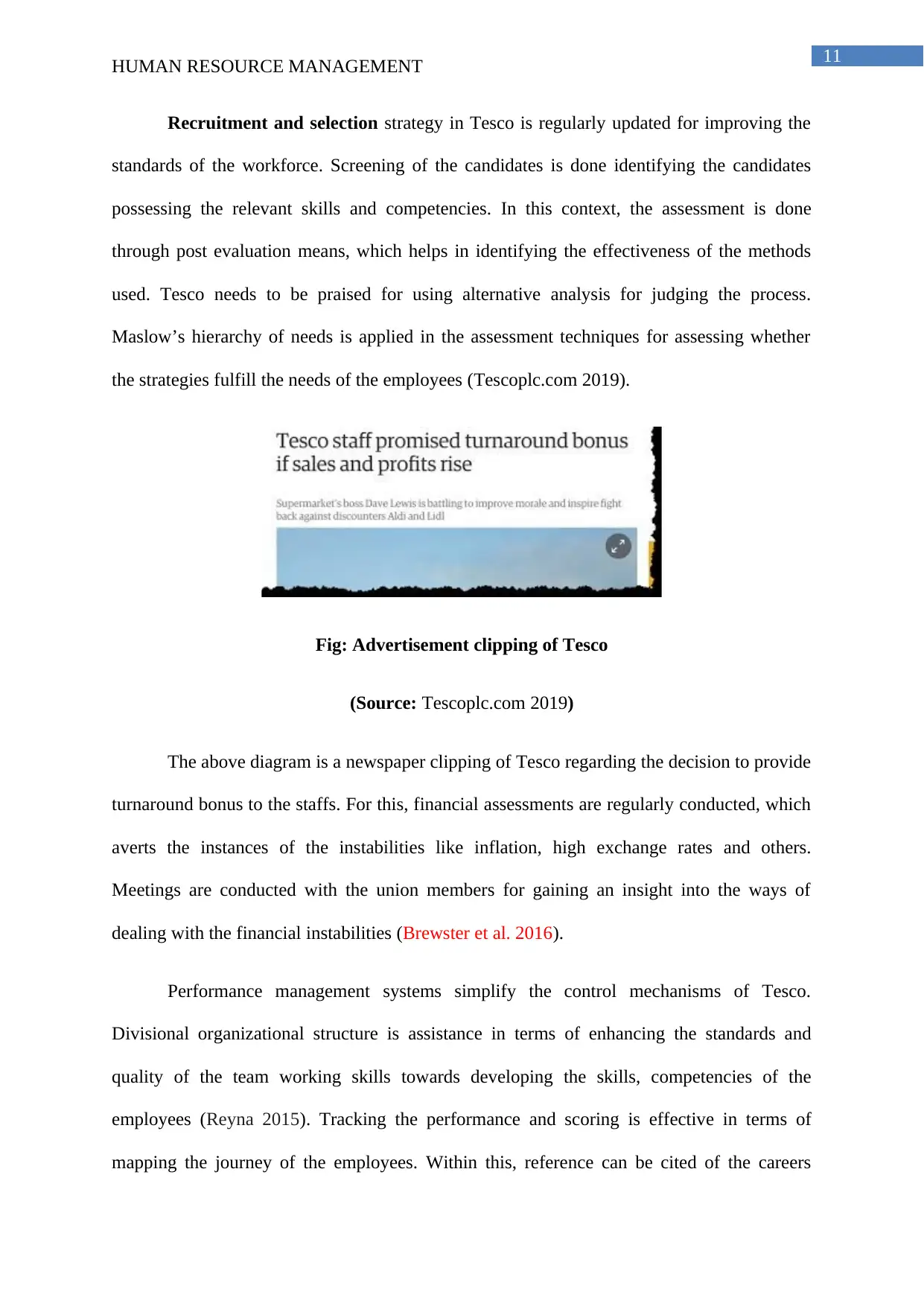
11
HUMAN RESOURCE MANAGEMENT
Recruitment and selection strategy in Tesco is regularly updated for improving the
standards of the workforce. Screening of the candidates is done identifying the candidates
possessing the relevant skills and competencies. In this context, the assessment is done
through post evaluation means, which helps in identifying the effectiveness of the methods
used. Tesco needs to be praised for using alternative analysis for judging the process.
Maslow’s hierarchy of needs is applied in the assessment techniques for assessing whether
the strategies fulfill the needs of the employees (Tescoplc.com 2019).
Fig: Advertisement clipping of Tesco
(Source: Tescoplc.com 2019)
The above diagram is a newspaper clipping of Tesco regarding the decision to provide
turnaround bonus to the staffs. For this, financial assessments are regularly conducted, which
averts the instances of the instabilities like inflation, high exchange rates and others.
Meetings are conducted with the union members for gaining an insight into the ways of
dealing with the financial instabilities (Brewster et al. 2016).
Performance management systems simplify the control mechanisms of Tesco.
Divisional organizational structure is assistance in terms of enhancing the standards and
quality of the team working skills towards developing the skills, competencies of the
employees (Reyna 2015). Tracking the performance and scoring is effective in terms of
mapping the journey of the employees. Within this, reference can be cited of the careers
HUMAN RESOURCE MANAGEMENT
Recruitment and selection strategy in Tesco is regularly updated for improving the
standards of the workforce. Screening of the candidates is done identifying the candidates
possessing the relevant skills and competencies. In this context, the assessment is done
through post evaluation means, which helps in identifying the effectiveness of the methods
used. Tesco needs to be praised for using alternative analysis for judging the process.
Maslow’s hierarchy of needs is applied in the assessment techniques for assessing whether
the strategies fulfill the needs of the employees (Tescoplc.com 2019).
Fig: Advertisement clipping of Tesco
(Source: Tescoplc.com 2019)
The above diagram is a newspaper clipping of Tesco regarding the decision to provide
turnaround bonus to the staffs. For this, financial assessments are regularly conducted, which
averts the instances of the instabilities like inflation, high exchange rates and others.
Meetings are conducted with the union members for gaining an insight into the ways of
dealing with the financial instabilities (Brewster et al. 2016).
Performance management systems simplify the control mechanisms of Tesco.
Divisional organizational structure is assistance in terms of enhancing the standards and
quality of the team working skills towards developing the skills, competencies of the
employees (Reyna 2015). Tracking the performance and scoring is effective in terms of
mapping the journey of the employees. Within this, reference can be cited of the careers
⊘ This is a preview!⊘
Do you want full access?
Subscribe today to unlock all pages.

Trusted by 1+ million students worldwide
1 out of 22
Related Documents
Your All-in-One AI-Powered Toolkit for Academic Success.
+13062052269
info@desklib.com
Available 24*7 on WhatsApp / Email
![[object Object]](/_next/static/media/star-bottom.7253800d.svg)
Unlock your academic potential
Copyright © 2020–2025 A2Z Services. All Rights Reserved. Developed and managed by ZUCOL.





